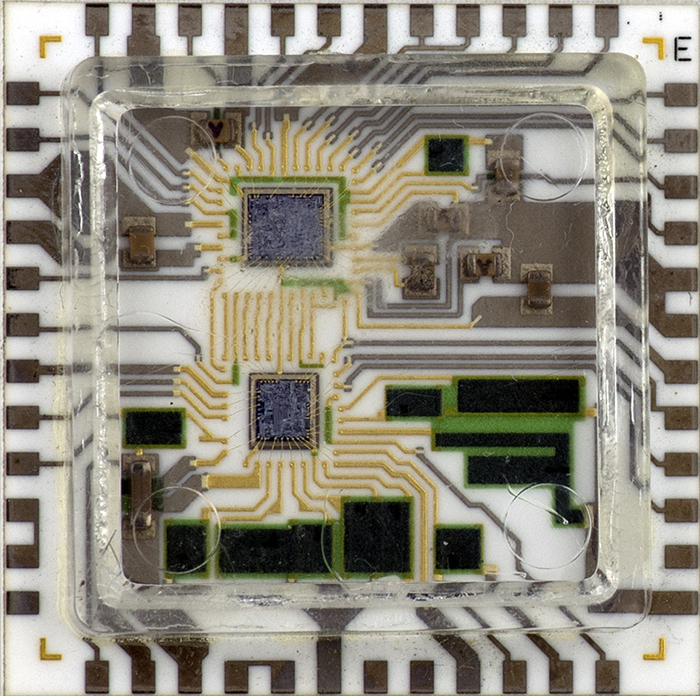Tektronix began designing and fabricating thick and thin film hybrids to meet the size and performance characteristics needed for their products. A hybrid, also known as a hybrid circuit, is a miniaturized electronic circuit constructed of individual devices, such as transistors, diodes or integrated circuits and passive components, such as resistors, inductors, and capacitors, bonded to a substrate.
Thick film refers to the interconnect medium. Screen printed thick film interconnect has larger feature sizes and deposited resistors wider in tolerance. One advantage is in the choice of resistor value as planar resistors are screen printed. The composition and dimensions of resistors can be selected to provide the desired values. The final resistor value is determined by design and can be adjusted by laser trimming.
Thin film interconnects were formed by a layer of gold by evaporation. Photoresist was used to form solder compatible connection pads and the gold layer etched to form the interconnects. Resistors were also formed, also by a photoresist and etching process and could be trimmed to a high precision by selective adonization of the film.
This 387-8775-88 hybrid ceramic substrate features four identical hybrid circuits.

This 2465 sweep hybrid was shown at the 1983 Technology Fair which highlighted internal capabilities to the various design organizations.

The circuitry was encapsulated in clear plastic for demonstration.

This 165-0041-00 hybrid uses the M859A preamp integrated circuit and is used in the TDS3000 series oscilloscopes.

Four of the hybrids make up the acquisition path circuitry on this TDS3000 series oscilloscope main board. The three larger white components are the series path relays.

In the mid-1980s Tektronix began outside services for their hybrid capabilities. This 1985 Tektronix Hybrid Circuits Engineering Applications Guide features their capabilities. Click on the image to view the PDF.
This November 1985 Design For Quality Hybrid Circuit Operation xxx. Click on the image to view the PDF.
In the mid 1990s, the Hybrid Circuits Operation (HCO) was spun out as a 50-50 joint venture with Maxim to form Maxtek Components Corporation. In the early 2000s, Maxtek was fully purchased by Tektronix to provide high performance interconnect technology needed for their advanced integrated circuits, and continued to operate under the Maxtek tradename for their external business. In 2010, after the acquisition of Tektronix by Danaher, the Maxtek tradename was dropped and the organization became Tektronix Component Solutions (TCS). TCS products and services included analog and mixed-signal ASIC design, IC packaging, RF and microwave modules, high-performance data converters, and component test.


